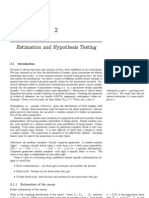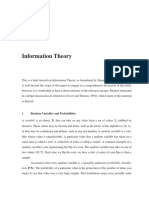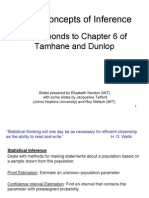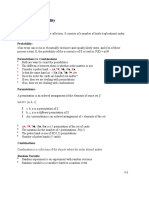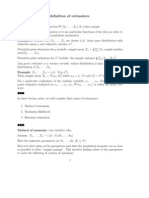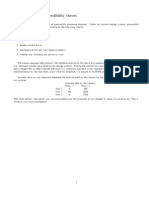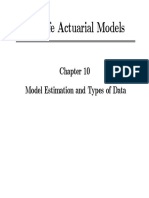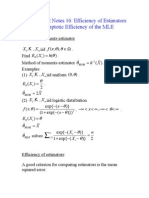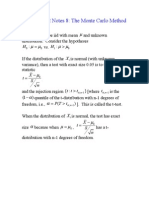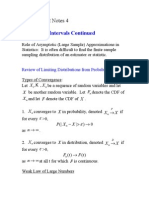Statistics 512 Notes I D. Small
Uploaded by
Sandeep SinghStatistics 512 Notes I D. Small
Uploaded by
Sandeep SinghStatistics 512 Notes I D.
Small
Reading: Section 5.1
Basic idea of statistical inference:
Statistical Experiment: Observe data X. The distribution of
X is P.
( ) "Probability X is in E" P X E
Model: Family of possible Ps.
, } P P
{
.
We call a parameter of the distribution.
Examples:
Population
Inference about
population using
statistical tools
Sample
of Data
1. Binomial model. Toss a coin n independent times.
P(Success)=p.
X=# of successes
[0,1]
2. Normal location model. Observe X=(X
1
,...,X
n
), X
i
independent and identically distributed (iid) with a normal
distribution with unknown mean
and known variance
2
.
2
2
1 1
( ; ) exp{ ( ) }
2
2
f x x
( , )
3. Normal model with unknown mean and variance.
Observe X=(X
1
,...,X
n
), X
i
iid with a normal distribution
with unknown mean
and unknown variance
2
.
( , ) (0, )
4. Nonparametric model. Observe X=(X
1
,...,X
n
), X
i
iid real
valued.
{all distributions on }
i
{cdf of distribution of X }
5. Survey sampling. There is a finite population of units
1,...,N that have variables Y
1
,...,Y
N
associated with them.
We observe Y for n of the units u
1
,...,u
n
, i.e., we observe
X
1
=Y
u1
,...,X
n
=Y
un
.
1
{ ,..., }
N
Y Y
We are usually interested in a particular function of such
as the population mean,
1 N
Y Y
N
+ + L
Two methods of choosing the units:
(A) Sampling with replacement: u
1
,...,u
n
are iid from the
uniform distribution on {1,2,...,N}.
(B) Sampling without replacement (simple random
sample): Each unit will appear in the sample at most once.
Each of the possible
N
n
_
,
samples has the same probability.
If N is much greater than n, the two sampling methods are
practically the same.
Statistical Inference: Statement about some aspect of
based on a statistical experiment.
Note: We might not be interested in the entire but only
some function of it, e.g., in Examples 3 and 4, we might
only be interested in the mean of the distribution.
Types of Inferences we will study:
1. Point estimation: Give best estimate of function of
we are interested.
2. Interval estimation (confidence intervals): Give an
interval (set) in which function of lies along with a
statement about how certain we are that function of
lies in the interval.
3. Hypothesis testing: Choose between two hypotheses
about
Point Estimation
Goal of point estimation is to provide the single best
guess of some quantity of interest g( ).
g( ) is a fixed unknown quantity.
A point estimator is any function of the data h(X). The
point estimator depends on the data so h(X) is a random
variable.
Examples of point estimators:
Binomial model: X~Binomial(n,p), n known
Point estimator for p: h(X)=X/n
Notation: We sometimes denote point estimator for a
parameter by putting a hat on it, i.e.,
/ p X n
. Also we
sometimes add a subscript n to denote the sample size,
/
n
p X n
.
Normal model with unknown mean
and known or
unknown variance
2
Point estimator for
:
1
n
n
X X
X
n
+ +
L
Sampling distribution: A point estimator h(X) is a function
of the sample so h(X) is a random variable. The
distribution of a point estimator h(X) for repeated samples
is called the sampling distribution of h(X).
Example: Normal location model. Observe X=(X
1
,...,X
n
),
X
i
independent and identically distributed (iid) with a
normal distribution with unknown mean
and known
variance
2
.
1
n
n
X X
X
n
+ +
L
Sampling distribution:
2
~ ( , )
n
N
n
Properties of a point estimator:
1. Bias. The bias of an estimator of
( ) g
is defined by
1 n 1 n
bias [h(X ,,X )] E [h(X ,,X )]-g( )
We say that h(X
1
,...,X
n
) is unbiased if
1
bias [h(X , , X )] 0
n
K
for all
Here
E
refers to the expectation with respect to the
sampling distribution of the data
1
( ,..., ; )
n
f x x
. It does not
mean we are averaging over a distribution for .
An unbiased estimator is suitably centered.
2. Consistency: A reasonable requirement for an estimator
is that it should converge to the true parameter value as we
collect more and more information.
A point estimator h(X
1
,...,X
n
) of a parameter g( ) is
consistent if h(X
1
,...,X
n
)
( )
P
g
for all .
Recall definition of convergence in probability (Section
4.2). h(X
1
,...,X
n
)
( )
P
g
means that for all 0 > ,
1
lim [| ( ,..., ) ( ) | ] 0
n
n
P h X X g
.
3. Mean Square Error. A good estimator should on
average be accurate. A measure of the accuracy of an
estimator is the average squared error of the estimator:
2
1 n 1 n
MSE [h(X ,...,X )] E [{h(X ,...,X )- } ]
Example: Suppose that an iid sample X
1
,...,X
n
is drawn
from the uniform distribution on [0, ] where is an
unknown parameter and the distribution of X
i
is
1
0<x<
( ; )
0 elsewhere
X
f x
'
Consider the following estimator of :
W=h(X
1
,...,X
n
)=max
i
X
i
Sampling distribution of W:
If w<0, P( W w )=0. If 0<w< ,
1 1
( ) ( ,..., ) [ ( ]
n
n
n
w
P W w P X X w P X w
_
,
If w , P( W w )=0.
Thus,
0 if w<0
( ) if 0 w
1 if w>
n
W
w
F w
_
'
,
and
1
0 w
( )
0 elsewhere
n
n
W
nw
f w
'
Bias:
1 1
0 0
0
E [W] ( )
( 1) 1
n n
W
n n
nw nw n
wf w dw w dw
n n
+
_
+ +
,
1
[ ]
1 1
n
Bias E W
n n
+ +
There is a bias in W but it might still be consistent.
Consistency:
Let W
n
denote W for a sample of size n.
For any 0 > ,
1
(| | ) ( )
( )
1
n n
n
n n
n n
n
n n
P W P W
n w w
dw
< < < +
_
,
Note that for any 0 > , it is possible to find an
n
making
[( ) / ]
n
as small as desired. Thus,
lim (| | ) 1
n n
P W
<
and W
n
is consistent.
You might also like
- (Ebook) Linear Algebra: Theory and Applications, 2nd Edition by Cheney ISBN 9781449613532, 1449613535 - The full ebook with complete content is ready for download100% (2)(Ebook) Linear Algebra: Theory and Applications, 2nd Edition by Cheney ISBN 9781449613532, 1449613535 - The full ebook with complete content is ready for download57 pages
- Introduction Statistics Imperial College London50% (2)Introduction Statistics Imperial College London474 pages
- Random Signals: 1 Kolmogorov's Axiomatic Definition of ProbabilityNo ratings yetRandom Signals: 1 Kolmogorov's Axiomatic Definition of Probability14 pages
- Information Theory: 1 Random Variables and Probabilities XNo ratings yetInformation Theory: 1 Random Variables and Probabilities X8 pages
- Basic Concepts of Inference: Corresponds To Chapter 6 of Tamhane and DunlopNo ratings yetBasic Concepts of Inference: Corresponds To Chapter 6 of Tamhane and Dunlop40 pages
- Chapter 4: Probability Distributions: 4.1 Random Variables100% (1)Chapter 4: Probability Distributions: 4.1 Random Variables53 pages
- R300 Advanced Econometrics Methods Lecture SlidesNo ratings yetR300 Advanced Econometrics Methods Lecture Slides362 pages
- 1 Regression Analysis and Least Squares EstimatorsNo ratings yet1 Regression Analysis and Least Squares Estimators7 pages
- Theory of Estimation by P.G.dixit, Nirali PublicationNo ratings yetTheory of Estimation by P.G.dixit, Nirali Publication186 pages
- Prof Stanley Dukin Lectures Statistical MechanicsNo ratings yetProf Stanley Dukin Lectures Statistical Mechanics43 pages
- Point Estimation: Definition of EstimatorsNo ratings yetPoint Estimation: Definition of Estimators8 pages
- 1 Regression Analysis and Least Squares EstimatorsNo ratings yet1 Regression Analysis and Least Squares Estimators8 pages
- Statistical Foundations: SOST70151 - LECTURE 2No ratings yetStatistical Foundations: SOST70151 - LECTURE 243 pages
- Asymptotic Statistics (By Changliang ZOU)No ratings yetAsymptotic Statistics (By Changliang ZOU)115 pages
- 1.1 Parametric and Nonparametric Statistical InferenceNo ratings yet1.1 Parametric and Nonparametric Statistical Inference8 pages
- Nonlife Actuarial Models: Model Estimation and Types of DataNo ratings yetNonlife Actuarial Models: Model Estimation and Types of Data35 pages
- Student's Solutions Manual and Supplementary Materials for Econometric Analysis of Cross Section and Panel Data, second editionFrom EverandStudent's Solutions Manual and Supplementary Materials for Econometric Analysis of Cross Section and Panel Data, second editionNo ratings yet
- Statistics 512 Notes 26: Decision Theory Continued: FX FX DNo ratings yetStatistics 512 Notes 26: Decision Theory Continued: FX FX D11 pages
- Statistics 512 Notes 24: Uniformly Most Powerful Tests: X FX X FX X XNo ratings yetStatistics 512 Notes 24: Uniformly Most Powerful Tests: X FX X FX X X7 pages
- Statistics 512 Notes 25: Decision Theory: of Nature. The Set of All Possible Value ofNo ratings yetStatistics 512 Notes 25: Decision Theory: of Nature. The Set of All Possible Value of11 pages
- Statistics 512 Notes 12: Maximum Likelihood Estimation: X X PX XNo ratings yetStatistics 512 Notes 12: Maximum Likelihood Estimation: X X PX X5 pages
- Statistics 512 Notes 16: Efficiency of Estimators and The Asymptotic Efficiency of The MLENo ratings yetStatistics 512 Notes 16: Efficiency of Estimators and The Asymptotic Efficiency of The MLE6 pages
- Statistics 512 Notes 8: The Monte Carlo Method: X X H H X Is Normal (With UnknownNo ratings yetStatistics 512 Notes 8: The Monte Carlo Method: X X H H X Is Normal (With Unknown7 pages
- Confidence Intervals Continued: Statistics 512 Notes 4No ratings yetConfidence Intervals Continued: Statistics 512 Notes 48 pages
- Get Early Childhood Mathematics 2. Ed Edition Sperry Smith PDF Ebook With Full Chapters Now100% (8)Get Early Childhood Mathematics 2. Ed Edition Sperry Smith PDF Ebook With Full Chapters Now70 pages
- XI Maths Relations and Functions 2 of 2 WorksheetNo ratings yetXI Maths Relations and Functions 2 of 2 Worksheet2 pages
- Discrete Mathematics: Inst Ruct Ions T O Cand Idat EsNo ratings yetDiscrete Mathematics: Inst Ruct Ions T O Cand Idat Es2 pages
- Course Folder: Am 3206 / CSM 324: Operations ResearchNo ratings yetCourse Folder: Am 3206 / CSM 324: Operations Research3 pages
- B.A. (Prog..) Mathematics 2nd Semester-2023No ratings yetB.A. (Prog..) Mathematics 2nd Semester-20238 pages
- College Mathematics 9th Edition by Cleaves Hobbs ISBN Solution Manual100% (38)College Mathematics 9th Edition by Cleaves Hobbs ISBN Solution Manual12 pages
- Steve Warner , Larry Ronaldson , Deirdre Storck - SHSAT Verbal Prep Book To Improve Your Score In Two Months_ The Most Effective Strategies for Mastering Scrambled Paragraphs, Logical Reasoning and R100% (1)Steve Warner , Larry Ronaldson , Deirdre Storck - SHSAT Verbal Prep Book To Improve Your Score In Two Months_ The Most Effective Strategies for Mastering Scrambled Paragraphs, Logical Reasoning and R157 pages
- 2020-ML-Grade 12-Final Examination Memorandum - Paper 1No ratings yet2020-ML-Grade 12-Final Examination Memorandum - Paper 122 pages
- Course Instructors: Dr. Victor T. Odumuyiwa Dr. Ufuoma C. Ogude Department of Computer Sciences University of LagosNo ratings yetCourse Instructors: Dr. Victor T. Odumuyiwa Dr. Ufuoma C. Ogude Department of Computer Sciences University of Lagos22 pages
- Applied Econometric Time Series 3Rd Ed.: Chapter 3: Modeling VolatilityNo ratings yetApplied Econometric Time Series 3Rd Ed.: Chapter 3: Modeling Volatility80 pages
- Download Full Basic science concepts and applications for wastewater student workbook American Waterworks Association PDF All Chapters100% (1)Download Full Basic science concepts and applications for wastewater student workbook American Waterworks Association PDF All Chapters67 pages
- Ranjan Bose Information Theory Coding and Cryptography Solution Manual89% (38)Ranjan Bose Information Theory Coding and Cryptography Solution Manual61 pages
- (Ebook) Linear Algebra: Theory and Applications, 2nd Edition by Cheney ISBN 9781449613532, 1449613535 - The full ebook with complete content is ready for download(Ebook) Linear Algebra: Theory and Applications, 2nd Edition by Cheney ISBN 9781449613532, 1449613535 - The full ebook with complete content is ready for download
- Random Signals: 1 Kolmogorov's Axiomatic Definition of ProbabilityRandom Signals: 1 Kolmogorov's Axiomatic Definition of Probability
- Information Theory: 1 Random Variables and Probabilities XInformation Theory: 1 Random Variables and Probabilities X
- Basic Concepts of Inference: Corresponds To Chapter 6 of Tamhane and DunlopBasic Concepts of Inference: Corresponds To Chapter 6 of Tamhane and Dunlop
- Chapter 4: Probability Distributions: 4.1 Random VariablesChapter 4: Probability Distributions: 4.1 Random Variables
- 1 Regression Analysis and Least Squares Estimators1 Regression Analysis and Least Squares Estimators
- Theory of Estimation by P.G.dixit, Nirali PublicationTheory of Estimation by P.G.dixit, Nirali Publication
- 1 Regression Analysis and Least Squares Estimators1 Regression Analysis and Least Squares Estimators
- 1.1 Parametric and Nonparametric Statistical Inference1.1 Parametric and Nonparametric Statistical Inference
- Nonlife Actuarial Models: Model Estimation and Types of DataNonlife Actuarial Models: Model Estimation and Types of Data
- Student's Solutions Manual and Supplementary Materials for Econometric Analysis of Cross Section and Panel Data, second editionFrom EverandStudent's Solutions Manual and Supplementary Materials for Econometric Analysis of Cross Section and Panel Data, second edition
- Statistics 512 Notes 26: Decision Theory Continued: FX FX DStatistics 512 Notes 26: Decision Theory Continued: FX FX D
- Statistics 512 Notes 24: Uniformly Most Powerful Tests: X FX X FX X XStatistics 512 Notes 24: Uniformly Most Powerful Tests: X FX X FX X X
- Statistics 512 Notes 25: Decision Theory: of Nature. The Set of All Possible Value ofStatistics 512 Notes 25: Decision Theory: of Nature. The Set of All Possible Value of
- Statistics 512 Notes 12: Maximum Likelihood Estimation: X X PX XStatistics 512 Notes 12: Maximum Likelihood Estimation: X X PX X
- Statistics 512 Notes 16: Efficiency of Estimators and The Asymptotic Efficiency of The MLEStatistics 512 Notes 16: Efficiency of Estimators and The Asymptotic Efficiency of The MLE
- Statistics 512 Notes 8: The Monte Carlo Method: X X H H X Is Normal (With UnknownStatistics 512 Notes 8: The Monte Carlo Method: X X H H X Is Normal (With Unknown
- Confidence Intervals Continued: Statistics 512 Notes 4Confidence Intervals Continued: Statistics 512 Notes 4
- Get Early Childhood Mathematics 2. Ed Edition Sperry Smith PDF Ebook With Full Chapters NowGet Early Childhood Mathematics 2. Ed Edition Sperry Smith PDF Ebook With Full Chapters Now
- Discrete Mathematics: Inst Ruct Ions T O Cand Idat EsDiscrete Mathematics: Inst Ruct Ions T O Cand Idat Es
- Course Folder: Am 3206 / CSM 324: Operations ResearchCourse Folder: Am 3206 / CSM 324: Operations Research
- College Mathematics 9th Edition by Cleaves Hobbs ISBN Solution ManualCollege Mathematics 9th Edition by Cleaves Hobbs ISBN Solution Manual
- Steve Warner , Larry Ronaldson , Deirdre Storck - SHSAT Verbal Prep Book To Improve Your Score In Two Months_ The Most Effective Strategies for Mastering Scrambled Paragraphs, Logical Reasoning and RSteve Warner , Larry Ronaldson , Deirdre Storck - SHSAT Verbal Prep Book To Improve Your Score In Two Months_ The Most Effective Strategies for Mastering Scrambled Paragraphs, Logical Reasoning and R
- 2020-ML-Grade 12-Final Examination Memorandum - Paper 12020-ML-Grade 12-Final Examination Memorandum - Paper 1
- Course Instructors: Dr. Victor T. Odumuyiwa Dr. Ufuoma C. Ogude Department of Computer Sciences University of LagosCourse Instructors: Dr. Victor T. Odumuyiwa Dr. Ufuoma C. Ogude Department of Computer Sciences University of Lagos
- Applied Econometric Time Series 3Rd Ed.: Chapter 3: Modeling VolatilityApplied Econometric Time Series 3Rd Ed.: Chapter 3: Modeling Volatility
- Download Full Basic science concepts and applications for wastewater student workbook American Waterworks Association PDF All ChaptersDownload Full Basic science concepts and applications for wastewater student workbook American Waterworks Association PDF All Chapters
- Ranjan Bose Information Theory Coding and Cryptography Solution ManualRanjan Bose Information Theory Coding and Cryptography Solution Manual








